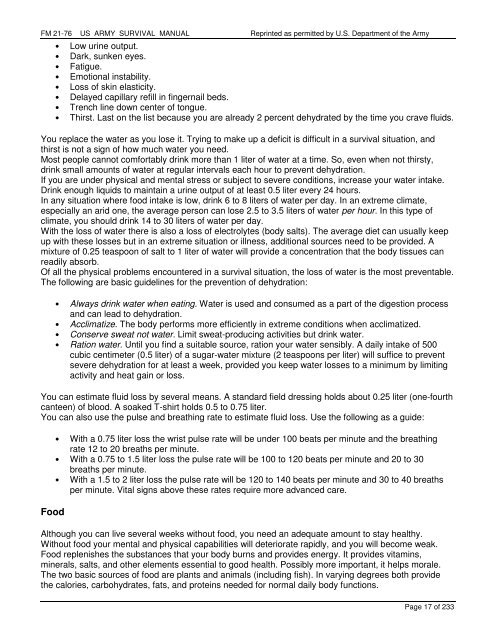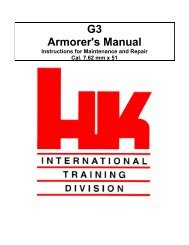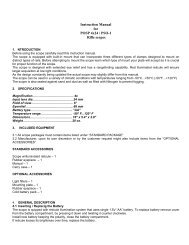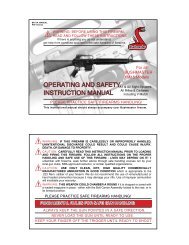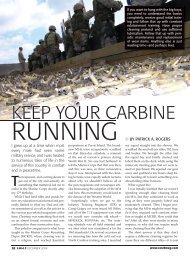FM 21-76 US ARMY SURVIVAL MANUAL - AR15.com
FM 21-76 US ARMY SURVIVAL MANUAL - AR15.com
FM 21-76 US ARMY SURVIVAL MANUAL - AR15.com
You also want an ePaper? Increase the reach of your titles
YUMPU automatically turns print PDFs into web optimized ePapers that Google loves.
<strong>FM</strong> <strong>21</strong>-<strong>76</strong> <strong>US</strong> <strong>ARMY</strong> <strong>SURVIVAL</strong> <strong>MANUAL</strong> Reprinted as permitted by U.S. Department of the Army<br />
• Low urine output.<br />
• Dark, sunken eyes.<br />
• Fatigue.<br />
• Emotional instability.<br />
• Loss of skin elasticity.<br />
• Delayed capillary refill in fingernail beds.<br />
• Trench line down center of tongue.<br />
• Thirst. Last on the list because you are already 2 percent dehydrated by the time you crave fluids.<br />
You replace the water as you lose it. Trying to make up a deficit is difficult in a survival situation, and<br />
thirst is not a sign of how much water you need.<br />
Most people cannot comfortably drink more than 1 liter of water at a time. So, even when not thirsty,<br />
drink small amounts of water at regular intervals each hour to prevent dehydration.<br />
If you are under physical and mental stress or subject to severe conditions, increase your water intake.<br />
Drink enough liquids to maintain a urine output of at least 0.5 liter every 24 hours.<br />
In any situation where food intake is low, drink 6 to 8 liters of water per day. In an extreme climate,<br />
especially an arid one, the average person can lose 2.5 to 3.5 liters of water per hour. In this type of<br />
climate, you should drink 14 to 30 liters of water per day.<br />
With the loss of water there is also a loss of electrolytes (body salts). The average diet can usually keep<br />
up with these losses but in an extreme situation or illness, additional sources need to be provided. A<br />
mixture of 0.25 teaspoon of salt to 1 liter of water will provide a concentration that the body tissues can<br />
readily absorb.<br />
Of all the physical problems encountered in a survival situation, the loss of water is the most preventable.<br />
The following are basic guidelines for the prevention of dehydration:<br />
• Always drink water when eating. Water is used and consumed as a part of the digestion process<br />
and can lead to dehydration.<br />
• Acclimatize. The body performs more efficiently in extreme conditions when acclimatized.<br />
• Conserve sweat not water. Limit sweat-producing activities but drink water.<br />
• Ration water. Until you find a suitable source, ration your water sensibly. A daily intake of 500<br />
cubic centimeter (0.5 liter) of a sugar-water mixture (2 teaspoons per liter) will suffice to prevent<br />
severe dehydration for at least a week, provided you keep water losses to a minimum by limiting<br />
activity and heat gain or loss.<br />
You can estimate fluid loss by several means. A standard field dressing holds about 0.25 liter (one-fourth<br />
canteen) of blood. A soaked T-shirt holds 0.5 to 0.75 liter.<br />
You can also use the pulse and breathing rate to estimate fluid loss. Use the following as a guide:<br />
Food<br />
• With a 0.75 liter loss the wrist pulse rate will be under 100 beats per minute and the breathing<br />
rate 12 to 20 breaths per minute.<br />
• With a 0.75 to 1.5 liter loss the pulse rate will be 100 to 120 beats per minute and 20 to 30<br />
breaths per minute.<br />
• With a 1.5 to 2 liter loss the pulse rate will be 120 to 140 beats per minute and 30 to 40 breaths<br />
per minute. Vital signs above these rates require more advanced care.<br />
Although you can live several weeks without food, you need an adequate amount to stay healthy.<br />
Without food your mental and physical capabilities will deteriorate rapidly, and you will become weak.<br />
Food replenishes the substances that your body burns and provides energy. It provides vitamins,<br />
minerals, salts, and other elements essential to good health. Possibly more important, it helps morale.<br />
The two basic sources of food are plants and animals (including fish). In varying degrees both provide<br />
the calories, carbohydrates, fats, and proteins needed for normal daily body functions.<br />
Page 17 of 233


